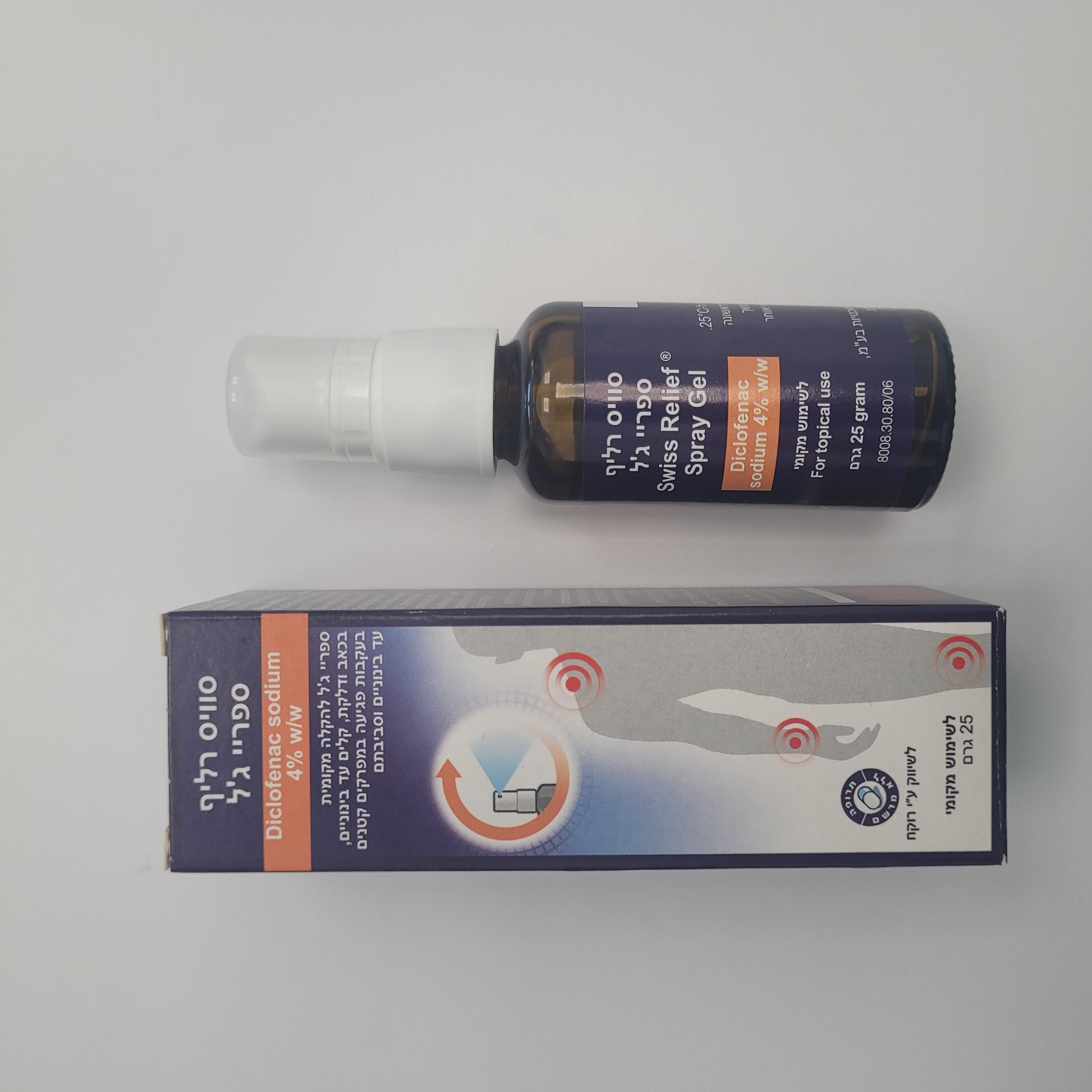Quest for the right Drug

סוויס רליף ספרי ג'ל SWISS RELIEF SPRAY GEL (DICLOFENAC SODIUM)
תרופה במרשם
תרופה בסל
נרקוטיקה
ציטוטוקסיקה
צורת מתן:
חיצוני : TOPICAL
צורת מינון:
תמיסה : SOLUTION
עלון לרופא
מינוניםPosology התוויות
Indications תופעות לוואי
Adverse reactions התוויות נגד
Contraindications אינטראקציות
Interactions מינון יתר
Overdose הריון/הנקה
Pregnancy & Lactation אוכלוסיות מיוחדות
Special populations תכונות פרמקולוגיות
Pharmacological properties מידע רוקחי
Pharmaceutical particulars אזהרת שימוש
Special Warning עלון לרופא
Physicians Leaflet
Pregnancy & Lactation : הריון/הנקה
4.6 Fertility, pregnancy and lactation Pregnancy The systemic concentration of Swiss relief Spray Gel is lower after topical administration, compared to oral formulations. With reference to experience from treatment with NSAIDs with systemic uptake, the following is recommended: Inhibition of prostaglandin synthesis may adversely affect the pregnancy and/or the embryo/foetal development. Data from epidemiological studies suggest an increased risk of miscarriage and of cardiac malformation and gastroschisis after use of a prostaglandin synthesis inhibitor in early pregnancy. The absolute risk for cardiovascular malformation was increased from less than 1%, up to approximately 1.5%. The risk is believed to increase with dose and duration of therapy. In animals, administration of a prostaglandin synthesis inhibitor has been shown to result in increased pre- and post-implantation loss and embryo-foetal lethality. In addition, increased incidences of various malformations, including cardiovascular, have been reported in animals given a prostaglandin synthesis inhibitor during the organogenetic period. During the first and second trimester of pregnancy, Swiss relief Spray Gel should not be used unless clearly necessary. If Swiss relief Spray Gel is used by a woman attempting to conceive, or during the first and second trimester of pregnancy, the dose should be kept as low and duration of treatment as short as possible. During the third trimester of pregnancy, all prostaglandin synthesis inhibitors may expose the foetus to: • cardiopulmonary toxicity (with premature closure of the ductus arteriosus and pulmonary hypertension); • renal dysfunction, which may progress to renal failure with oligo-hydroamniosis; The mother and the neonate, at the end of pregnancy, to: • possible prolongation of bleeding time, an anti-aggregating effect which may occur even at very low doses. • inhibition of uterine contractions resulting in delayed or prolonged labour. There are no clinical data from the use of Swiss relief Spray Gel during pregnancy. Even if systemic exposure is lower compared with oral administration, it is not known if the systemic Swiss relief Spray Gel exposure reached after topical administration can be harmful to an embryo/fetus. Therefore, Swiss relief Spray Gel is contraindicated during the third trimester of pregnancy (see Section 4.3). Fetal Toxicity Premature Closure of Fetal Ductus Arteriosus: Avoid use of NSAIDs, including Swiss relief Spray Gel, in pregnant women at about 28 weeks gestation and later. NSAIDs, including Swiss relief Spray Gel, increase the risk of premature closure of the fetal ductus arteriosus at approximately this gestational age. Oligohydramnios/Neonatal Renal Impairment: Use of NSAIDs, including Swiss relief Spray Gel, at about 20 weeks gestation or later in pregnancy may cause fetal renal dysfunction leading to oligohydramnios and, in some cases, neonatal renal impairment. These adverse outcomes are seen, on average, after days to weeks of treatment, although oligohydramnios has been infrequently reported as soon as 48 hours after NSAID initiation. Oligohydramnios is often, but not always, reversible with treatment discontinuation. Complications of prolonged oligohydramnios may, for example, include limb contractures and delayed lung maturation. In some postmarketing cases of impaired neonatal renal function, invasive procedures such as exchange transfusion or dialysis were required. If NSAID treatment is necessary between about 20 weeks and 28 weeks gestation, limit Swiss relief Spray Gel use to the lowest effective dose and shortest duration possible. Consider ultrasound monitoring of amniotic fluid if Swiss relief Spray Gel treatment extends beyond 5 days. Discontinue Swiss relief Spray Gel if oligohydramnios occurs and follow up according to clinical practice. Lactation Like other NSAIDs, diclofenac passes into breast milk in small amounts. However, at therapeutic doses of Swiss relief Spray Gel no effects on the suckling child are anticipated. Because of a lack of controlled studies in lactating women, the product should only be used during lactation under advice from a healthcare professional. Under this circumstance, Swiss relief Spray Gel should not be applied on the breasts of nursing mothers, nor elsewhere on large areas of skin or for a prolonged period of time (see section 4.4).

שימוש לפי פנקס קופ''ח כללית 1994
לא צוין
תאריך הכללה מקורי בסל
לא צוין
הגבלות
לא צוין
מידע נוסף
עלון מידע לצרכן
19.07.21 - עלון לצרכן אנגלית 19.07.21 - עלון לצרכן עברית 19.07.21 - עלון לצרכן ערבית 07.06.23 - עלון לצרכן אנגלית 07.06.23 - עלון לצרכן עברית 07.06.23 - עלון לצרכן ערבית 25.08.23 - עלון לצרכן אנגלית 12.11.23 - עלון לצרכן עברית 23.11.23 - עלון לצרכן אנגלית 23.11.23 - עלון לצרכן עברית 23.11.23 - עלון לצרכן ערבית 07.11.24 - עלון לצרכן עברית 11.01.21 - החמרה לעלון 19.07.21 - החמרה לעלון 29.08.21 - החמרה לעלון 18.04.16 - החמרה לעלון 25.08.23 - החמרה לעלון 07.11.24 - החמרה לעלוןלתרופה במאגר משרד הבריאות
סוויס רליף ספרי ג'ל